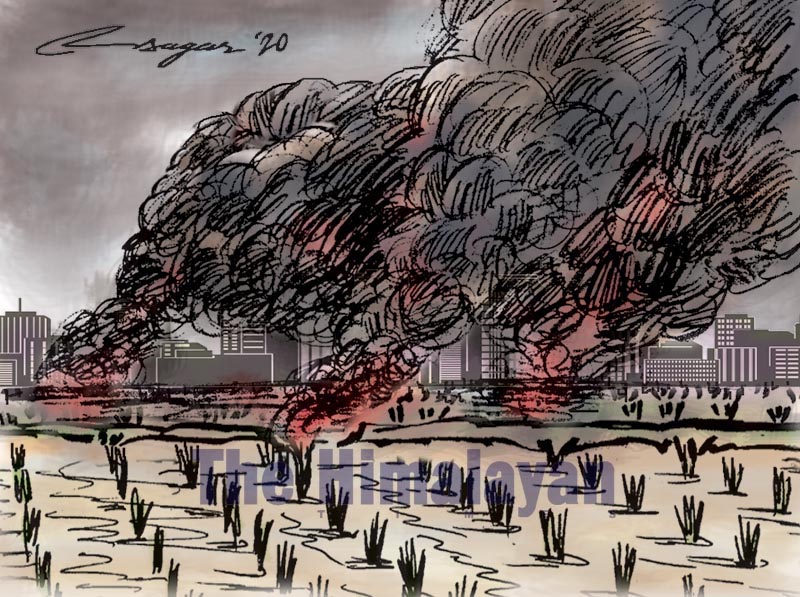Don’t burn the stubble: Upcycle or recycle crop residue
Relying heavily on just one or two crops has always been a terrible idea. India’s granary, Punjab, resorted to rice-wheat rotation after displacing other traditional crops, including barley and pulses, more suited to the region
A lot of noise is made throughout India, from Punjab and Haryana to Delhi, during the paddy harvesting season. Stubble burning isn’t an act of ignorance or illiteracy but of rebellion and helplessness. Rebellion towards government lethargy and helplessness, because farmers are threatened by increasing economic marginality and eventual extinction. According to the Economic Survey of India 2018, the incomes of Indian farmers have been stagnant since the last three years, bringing some kind of a morbid sense into the statistics of 45 farmers committing suicide every day in India. Machines are unaffordable, and there isn’t any facility to dump crop residues.
During the National Conference on Agriculture for Kharif Campaign in 2017, crop residue management alternatives to prevent stubble burning were discussed and debated. From retention of crop residue as mulch to government’s responsibility by giving reasonable subsidy on equipment, everything was expected to be sorted out. Still, the ‘burning issue’ seems to be on the back burner even while humans choke. Adapting to the changing needs of the society, which is nothing but embracing farming techniques with a touch of humanity, will end slash and burn. Farmers reeling under debts, penury and poverty will opt for easy and quick ways to clear their fields. With facts and statistics at our disposal, farm fires can be blamed for 40 per cent of the total pollution in New Delhi. Still, it can’t be ignored at least twice a year, just as we can’t turn a blind eye to a governance deficit.
Multi-pronged strategies devised two years back at the conclusion of the two-day national conference to double farmers’ incomes by 2022 and the eight groups that were formed to discuss in-depth on the best mechanisation practices to avoid burning of straw in addition to market reforms and many more haven’t lighted any lamp at the end of any tunnel.
It all goes back to the green revolution of 1965 that introduced high yield varieties of rice and wheat with unintended ecological and socio-economic repercussions. Yes, Punjab’s ‘story’ of prosperity in disguise once began with the green revolution and government incentives and subsidies. An undisputed fact is nature abhors monoculture. The practice of relying heavily on just one or two crops has always been a terrible idea. The granary of India resorted to rice-wheat rotation after displacing other traditional crops, including barley and pulses, more suited to the region. Is the miracle of the green revolution still making sense? The Punjab Agricultural University (PAU) in Ludhiana that has emerged as a centre of excellence in agriculture research can always pitch in with their expertise to find feasible alternatives to stubble burning and convince the farmers and the government too if need be. It’s through that diversity that we can sequester carbon [and] put that carbon into the soil. That carbon, in turn, through the soil biology, is what produces healthy crops, healthy animals, and eventually healthy people.
Unfortunately, today, stubble burning alone doesn’t plague this land. Dry/contaminated dug wells, intermittent supply from tube wells, reduced storage capacity in water reservoirs and depleted ground water looms over the farmers as the smog over the Indian capital. Stubble burning is also a reflection of the agrarian crisis hitting India’s granary.
Fool proof solutions offered by R&D institutes and entrepreneurs to handle wheat and paddy stubble are aplenty, ruling out the need for conferences, national and international and symposiums on crop residue management. Governments that encouraged mono-cropping and double cropping with all enthusiasm must ensure alignment between different ministries to end stubble burning, advocate and promote no-till farming practices with all possible resources instead of doles and fines, encourage industries that can use crop residue as raw material by incentivising them.
Timely intervention with judicious solutions during that short window between harvesting paddy and preparing the field for sowing the successive wheat crop will pave way for pollution-free states.
The country is swift and prompt when it comes to building statues or launching satellites or procuring arms or modernising the nuclear arsenal. It’s a pity that governments are helpless when it comes to helping poor farmers. We can take enough lessons on crop residue management from the Philippines and countries where paddy cultivation is done extensively.
Massive institutional support by the state, including assured price and marketing support, addressed the food security needs since the green revolution in Punjab. What’s preventing the same institution from helping farmers to stop stubble burning? Composting crop residue or maize as an alternative to paddy or no-till farming or making a happy/superseeder affordable are all possible feasible solutions with an effective vigilant monitoring network. Citizens can wish, pray and hope the government think-tanks will come up with a clear, level-headed permanent solution to this perennial problem. What is most urgent is to eliminate those cartels of middlemen and agents thriving in markets established under the Agricultural Produce Market Committee Act-1963. Overall growth objectives should never clash with sustainability concerns and never with human welfare.






